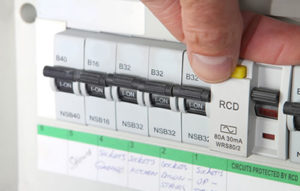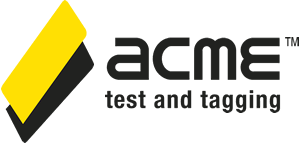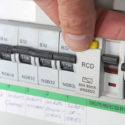
Office equipment test and tagging
23/01/2014
Test & Tag Fraud Alert
21/10/2016Testing requirements for RCD & Safety Switch used in workplaces
Residual Current Devices (RCDs) – also known as “safety switches” – are an important safety device that provide protection against electric shock.
RCDs are designed to protect people from electric shock whereas circuit breakers are designed to detect overload situations and protect the building and/or the appliance.
RCDs are typically found in the main switch-board of buildings and homes. Many manufacturers now incorporate RCDs into extension leads, power-boards or hand held appliances.
Portable RCDs are also available that plug directly into a power outlet. Many generators have RCDs incorporated into the power outlets.
As part of your electrical appliance safety program, ALL the RCDs used in your workplace MUST be tested regularly to ensure they are working correctly. The reason they need regular testing is dust, grit, lack of use or physical damage can cause the internal components to fail or the moving parts to “stick”, slow down or prevent it from tripping at all! You don’t want that happen.
The Standard AS/NZS 3760 sets out the maximum tripping time for a Type II RCDRCD is an acronym for Residual Current Device. They are also known as safety switches. RCDs are designed to protect people from electric shock. More shall not be greater than 300 msmilliSecond = 1/1,000 of a second The symbol is mS More. That’s 0.300 of a second and is actually faster than you can blink!
There are two tests that need to be regularly performed;
The “push button” test is designed to provide an indication the RCDRCD is an acronym for Residual Current Device. They are also known as safety switches. RCDs are designed to protect people from electric shock. More is working; you simply push the “test button” and the RCDRCD is an acronym for Residual Current Device. They are also known as safety switches. RCDs are designed to protect people from electric shock. More should trip “without undue delay”. This quick and simple test is commonly used with portable RCDs and should be performed daily or before each time you use the RCDRCD is an acronym for Residual Current Device. They are also known as safety switches. RCDs are designed to protect people from electric shock. More – which ever is the longer. However it is not particularly accurate and should never be relied on as a reliable assessment of the RCDRCD is an acronym for Residual Current Device. They are also known as safety switches. RCDs are designed to protect people from electric shock. More working correctly.
The “trip timeThe trip time is the measurement of the time taken for a Residual Current Device (RCD) to trip (break the circuit). This should occur when a value greater than the rated tripping current of the RCD is detected. The measurement is recorded in milli-seconds. We provide RCD or trip time testing in Melbourne for any business or workplace. More” test using the “applied current” method is a far more accurate means of testing RCDs and is a required test under AS/NZS 3760. It measures the actual trip timeThe trip time is the measurement of the time taken for a Residual Current Device (RCD) to trip (break the circuit). This should occur when a value greater than the rated tripping current of the RCD is detected. The measurement is recorded in milli-seconds. We provide RCD or trip time testing in Melbourne for any business or workplace. More and must be performed with equipment able to measure this to within +/- 8 msmilliSecond = 1/1,000 of a second The symbol is mS More ( 0.008 of a second ).
The Standard also sets out the intervals to retest the RCDs under various uses and environments. For commercial cleaning use it’s every 6 months, workshops and the like every 12 months, residential facilities and low risk environments every 2 years. ( see Table 4 AS/NZS 3760 )
Don’t forget the RCDRCD is an acronym for Residual Current Device. They are also known as safety switches. RCDs are designed to protect people from electric shock. More on your generator; it must be tested on a regular basis as well.
What about RCDs used by builders and tradepersons or on construction and demolition sites ( Victoria )?
Specific regulations and requirements apply to the use of RCDs on construction and demolition sites. These not only cover portable devices, but also those used in the temporary power supply box, transportable structures etc. ( see AS/NZS 3012 )
Portable RCDs, such as those incoporated in powerboards, must be “trip time” tested every three months.
However, the Industry Standard for Electrical Installations on Construction Sites (March 2002) leaves some ambiguity about the requirements; Section 4.4 states;
All portable RCDs shall be tested before each use by operation of the test button.
All RCDs should be tested for tripping current and time by a licensed electrician each calendar month while being used on the site.
The issue is through the use of the word “should” which is used to indicate recommended safe practices and procedures. Should means it is not mandatory and you have other options such as using a “competent person”, as defined under AS/NZS 3760 (and 3012), who knows how to correctly perform the required testing procedures.
That said, when in doubt, always adopt the best practice.
By John Blackburn
PS ACME Test and Tagging provides a fully compliant RCD / Safety Switch testing service. Contact us today to discuss the requirements for your workplace.
Minor revisions:
15/08/16
5/11/2014
21/03/2014
This information is general in nature, should be used as a guide only and read in conjunction with the relevant Standard(s), State and/or Federal Legislation, Codes of Practice and Industry Standards specific to your workplace. A proper risk assessment should be under taken before acting on the information provided in this document or any related material. Further information can also be obtained from your local Workplace Authority, Electrical Safety Authority or a suitably qualified persons. This article is copyright protected.



